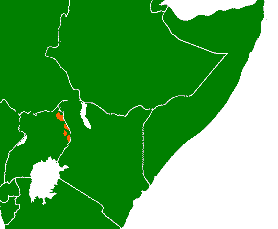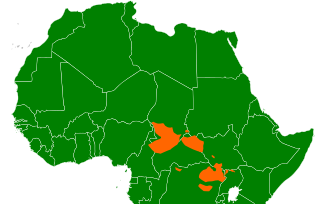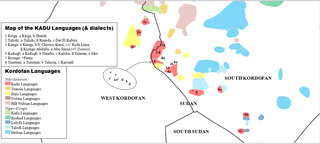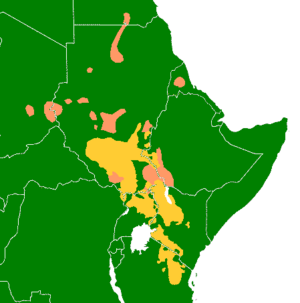
The Cushitic languages are a branch of the Afroasiatic language family. They are spoken primarily in the Horn of Africa, with minorities speaking Cushitic languages to the north in Egypt and Sudan, and to the south in Kenya and Tanzania. As of 2012, the Cushitic languages with over one million speakers were Oromo, Somali, Beja, Afar, Hadiyya, Kambaata, and Sidama.

The Kordofanian languages are a geographic grouping of five language groups spoken in the Nuba Mountains of the South Kordofan region of Sudan: Talodi–Heiban languages, Lafofa languages, Rashad languages, Katla languages and Kadu languages. The first four groups are sometimes regarded as branches of the hypothetical Niger–Congo family, whereas Kadu is now widely seen as a branch of the proposed Nilo-Saharan family.

The Nilo-Saharan languages are a proposed family of African languages spoken by somewhere around 70 million speakers, mainly in the upper parts of the Chari and Nile rivers, including historic Nubia, north of where the two tributaries of the Nile meet. The languages extend through 17 nations in the northern half of Africa: from Algeria to Benin in the west; from Libya to the Democratic Republic of the Congo in the centre; and from Egypt to Tanzania in the east.
The Nubian languages are a group of related languages spoken by the Nubians. In the past, Nubian languages were spoken throughout much of Sudan, but as a result of Arabization they are today mostly limited to the Nile Valley between Aswan and Al Dabbah. In the 1956 Census of Sudan there were 167,831 speakers of Nubian languages. Nubian is not to be confused with the various Nuba languages spoken in villages in the Nuba mountains and Darfur.

The Songhay, Songhai or Ayneha languages are a group of closely related languages/dialects centred on the middle stretches of the Niger River in the West African countries of Mali, Niger, Benin, Burkina Faso and Nigeria. In particular, they are spoken in the cities of Timbuktu, Djenné, Niamey and Gao. They have been widely used as a lingua franca in that region ever since the era of the Songhai Empire. In Mali, the government has officially adopted the dialect of Gao as the dialect to be used as a medium of primary education.
Tama, or Tamongobo, is the primary language spoken by the Tama people in Ouaddai, eastern Chad and in Darfur, western Sudan. It is a Taman language which belongs to the Eastern Sudanic branch of the Nilo-Saharan language family. Miisiirii is often considered a dialect, though it is not particularly close.
Shabo is an endangered language and likely language isolate spoken by about 400 former hunter-gatherers in southwestern Ethiopia, in the eastern part of the South West Ethiopia Peoples' Region.

The Nilotic languages are a group of related languages spoken across a wide area between South Sudan and Tanzania by the Nilotic peoples.

The Kuliak languages, also called the Rub languages, are a group of languages spoken by small relict communities in the mountainous Karamoja region of northeastern Uganda.

Central Sudanic is a family of about sixty languages that have been included in the proposed Nilo-Saharan language family. Central Sudanic languages are spoken in the Central African Republic, Chad, Sudan, South Sudan, Uganda, Congo (DRC), Nigeria and Cameroon. They include the pygmy languages Efé and Asoa.

The Kadu languages, also known as Kadugli–Krongo or Tumtum, are a small language family of the Kordofanian geographic grouping, once included in Niger–Congo. However, since Thilo Schadeberg (1981), Kadu is widely seen as Nilo-Saharan. Evidence for a Niger-Congo affiliation is rejected, and a Nilo-Saharan relationship is controversial. A conservative classification would treat the Kadu languages as an independent family.
The Surmic languages are a branch of the Eastern Sudanic language family.
Meʼen is a Nilo-Saharan language spoken in Ethiopia by the Meʼen people. In recent years, it has been written with the Geʽez alphabet, but in 2007 a decision was made to use the Latin alphabet. Dialects include Bodi (Podi) and Tishena.

The Majang language is spoken by the Majangir people of Ethiopia. Although it is a member of the Surmic language cluster, it is the most isolated one in the group. A language survey has shown that dialect variation from north to south is minor and does not seriously impede communication. The 2007 Ethiopian Census lists 6,433 speakers for Majang (Messengo), but also reports that the ethnic group consists of 32,822 individuals. According to the census, almost no speakers can be found in Mezhenger Zone of Gambela Region; a total of eleven speakers are listed for the zone, but almost 10,000 ethnic Mejenger or Messengo people.
The Aroid or Ari-Banna languages possibly belong to the Afro-Asiatic family and are spoken in Ethiopia.
The Bʼaga languages, also known as Gumuz, form small language family spoken along the border of Ethiopia and Sudan. They have been tentatively classified as closest to the Koman languages within the Nilo-Saharan language family.
The Northern Eastern Sudanic, Eastern k Sudanic, Ek Sudanic, NNT or Astaboran languages may form a primary division of the proposed Eastern Sudanic family. They are characterised by having a /k/ in the first person singular pronoun "I/me", as opposed to the Southern Eastern Sudanic languages, which have an /n/. Nyima has yet to be conclusively linked to the other languages, and would appear to be the closest relative of Ek Sudanic rather than Ek Sudanic proper.
The Southern Eastern Sudanic, Eastern n Sudanic, En Sudanic or Kir–Abbaian languages form one of two primary divisions of the Eastern Sudanic languages in the classification of Bender (2000). It is rejected as an established group in Starostin (2015).
The Burun languages are a branch of the Nilotic languages. They include:

The Nuba Mountains, located in the West Kordofan and South Kordofan states in the south of Sudan, are inhabited by a diverse set of populations speaking various languages not closely related to one another.










